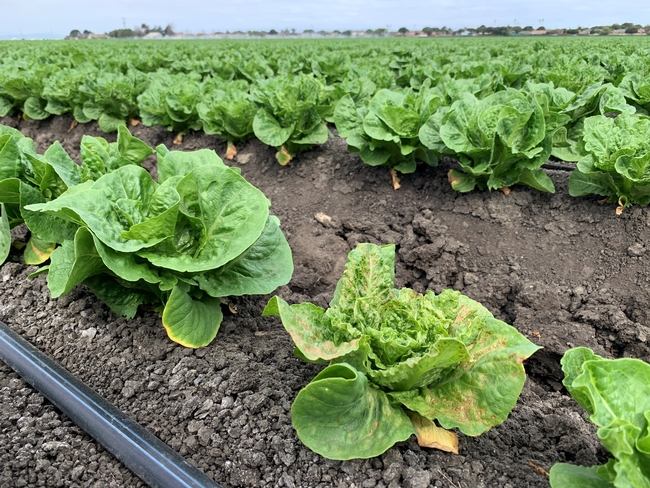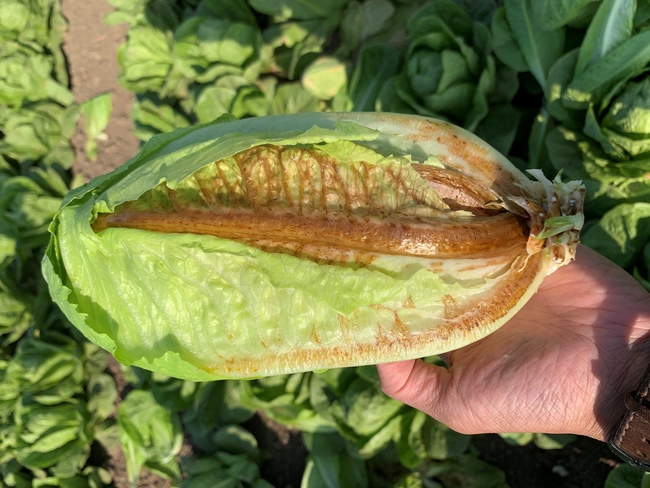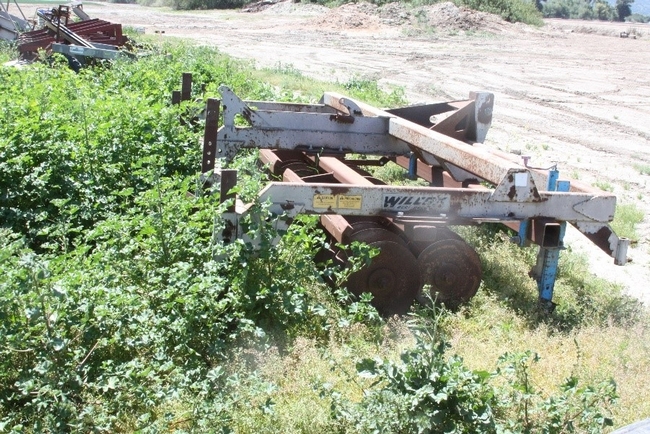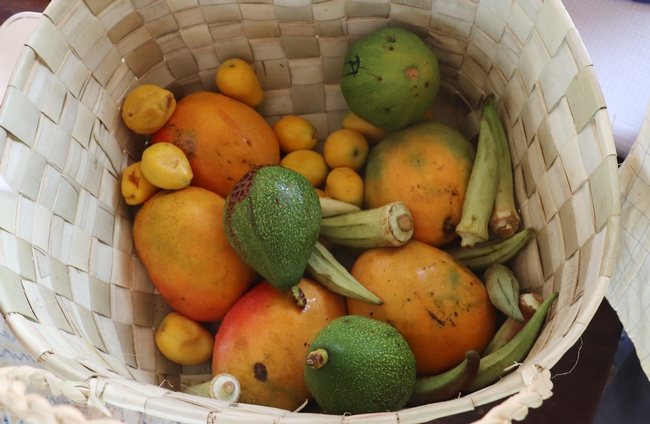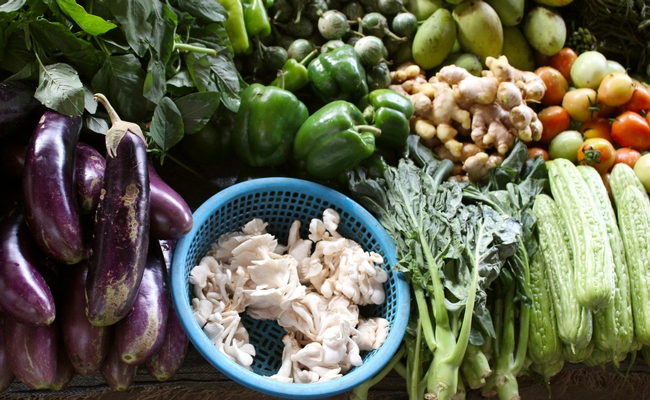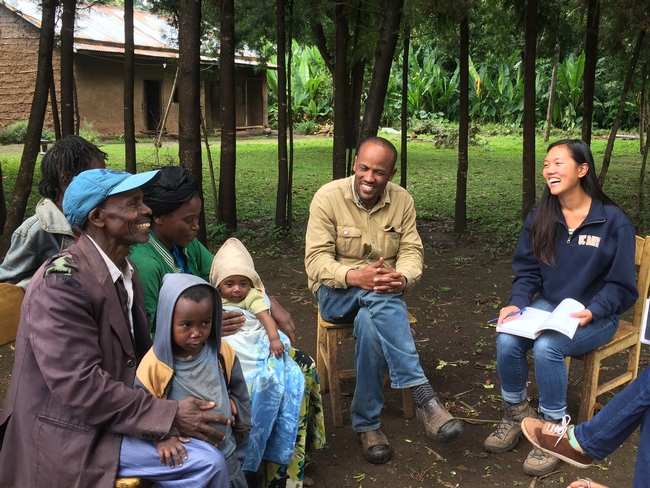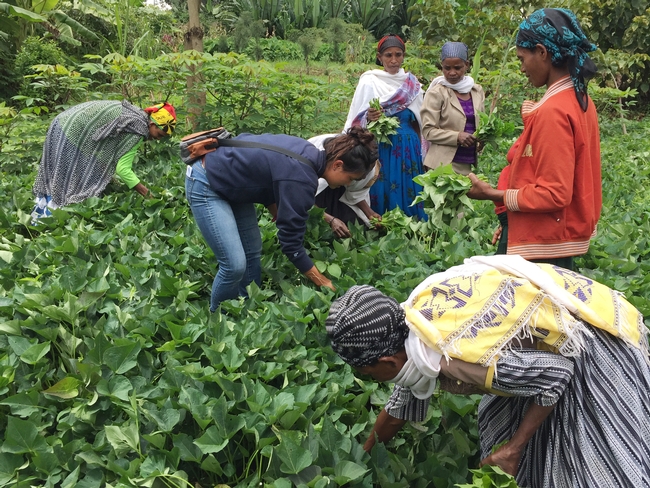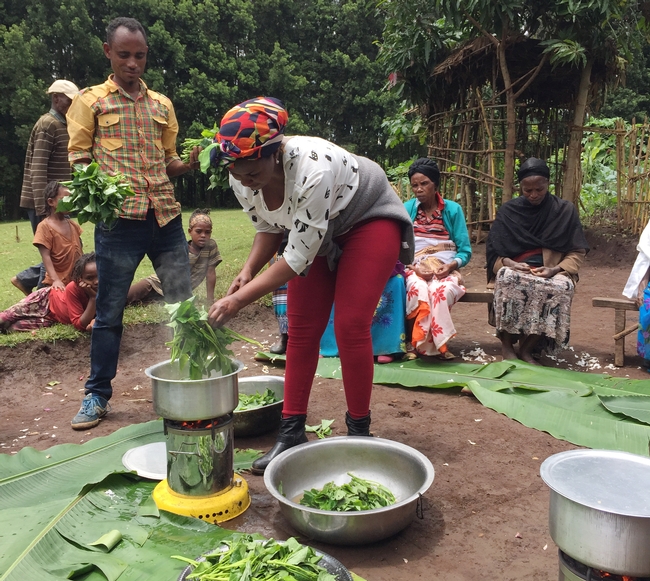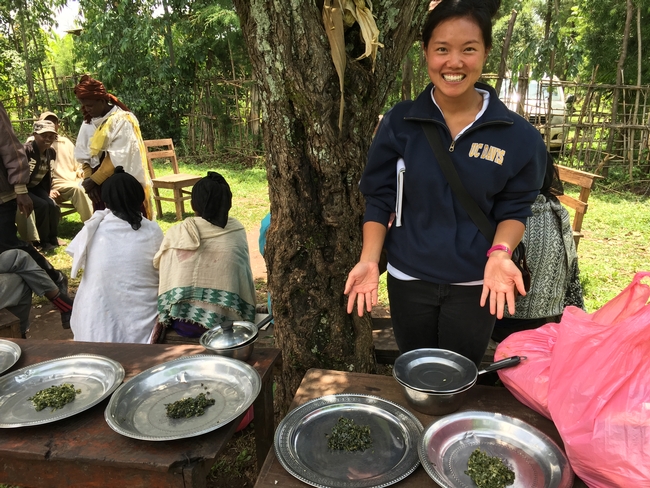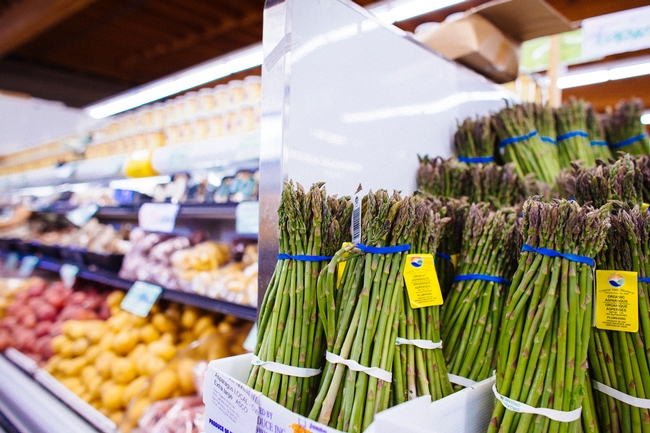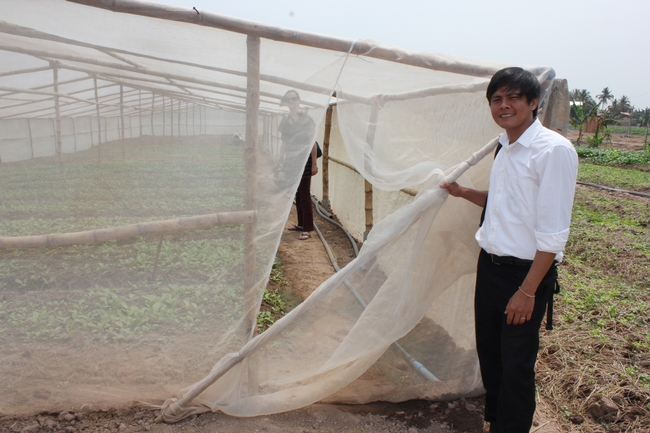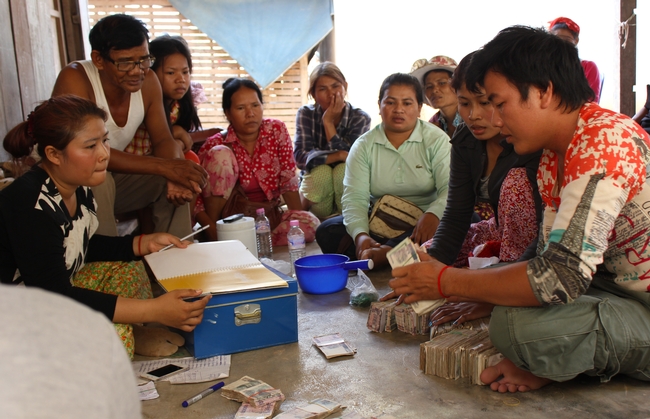Posts Tagged: Vegetables
Lettuce growers hope weeding, research can counter devastating plant virus
Population explosion of insect vector contributed to $100 million in losses in 2020
While most Californians are wholeheartedly embracing the wet start to winter, one group is welcoming the rain more warily (and wearily) – lettuce growers in the Salinas Valley.
“It's a blessing, yes, we need the water,” said Tony Alameda, managing partner of Topflavor Farms, which grows a variety of produce in Monterey and San Benito counties. “But, oh gosh: with that water, here come the weeds, here comes the habitat, here comes all the other problems that go along with it.”
Weeds are overwintering havens for a tiny insect called the Western flower thrips, which in turn carries the impatiens necrotic spot virus (INSV) – a plant virus that caused $100 million in lost gross revenue for Salinas Valley growers in 2020.
The agricultural community called it “the biggest problem we've seen in a long, long time,” said Mary Zischke, facilitator of a task force convened by the Grower-Shipper Association to address INSV and a related affliction, Pythium wilt.
Widespread crop failure in 2020
Since INSV was first observed in the state in 2006, the virus – which poses no threat to people – triggered significant crop losses in 2019, leading up to a catastrophic 2020. As Alameda's lettuces began to show the telltale “bronzing” of the leaves, efforts to bag up or remove the infected plants had no effect on the virus' implacable spread.
“Nothing seemed to work,” he recalled, “and you just watch those fields collapse, week after week, until you're just like, ‘Ugh, there's nothing here to even harvest.'”
After “100% crop failure” that year in his prime fields at the heart of the Salinas Valley, Alameda tried to dodge the virus in 2021 – shifting lettuce plantings to San Benito County and instead using his most valuable land for unaffected crops such as cilantro, leeks and radishes. By decamping to San Benito, Alameda was able to harvest 70% of his usual lettuce yield.
Generally, growers enjoyed a reprieve from virus pressures in 2021. Even in this “good” year, however, about one-third of all lettuce plantings in the Salinas Valley had at least a low level of infection, according to Zischke.
“Since we were attributing a lot of our so-called good fortune – on having less damage this year – to the cooler weather, we know we can't count on that to get us out of this problem,” Zischke said. “All the models point to the fact that we're in a warming climate, so we were fortunate this year.”
More research needed on thrips
Heat waves were a major driver of the INSV disaster of 2020. Although researchers have established a link between warmer temperatures and population increases of thrips, science still has a lot to learn about those disease vectors.
“Thrips are something we're trying to understand as much as we can, but it's pretty tough because they're a little mysterious in the way they get around and where they overwinter,” said Richard Smith, a University of California Cooperative Extension vegetable crops and weed science farm advisor for the Central Coast region.
Smith – along with U.S. Department of Agriculture research entomologist Daniel Hasegawa and California State University-Monterey Bay plant pathologist JP Dundore-Arias – provided an INSV update during an Assembly agriculture committee hearing in December.
Recent studies have identified several weeds as key “reservoirs” of thrips, including malva, marestail, and hairy fleabane. The ubiquitous mustards, fortunately, appear to be poor hosts for thrips, although their pollen serve as potential food sources.
Controlling those weeds – which are beginning to spring up as the days lengthen – is a top priority during the winter months, according to Smith. Aggressive weed management in the preceding winter was an important factor in limiting the virus' spread in 2021.
And because weeds recognize no boundaries, experts are also urging managers of non-agricultural lands to keep their properties as clean as possible, including industrial sites, equipment yards and the edges of roadways – namely U.S. Route 101, which runs through the center of the valley. Some growers have been volunteering to weed their neighbors' vineyards.
“We're encouraging everybody – as best they can – to knock down known weed hosts; that's really critical,” Zischke said.
Search for long-term solutions
Within the grower community, there is “nervous optimism” for the coming year, said Alameda, as he continues to hope for an innovation that would aid in the fight against INSV – whether a more targeted pesticide application or a beneficial insect that could deter the thrips.
However, both Alameda and Zischke pointed to the breeding of more resistant lettuce varieties as the ultimate solution to INSV – albeit one that is years away.
“We have a lot of different types of lettuce that we grow, so to move resistance into all the different types of lettuce we grow throughout the season … that's going to take time,” Zischke explained.
Research funding from the state and USDA – as well as projects supported by the California Leafy Greens Research Program – can help expedite that process. But, for Alameda, the INSV crisis underscores the need for more resources and farm advisors such as Smith, who has spent more than three decades cultivating relationships and building trust within Salinas Valley communities.
Alameda would like to see a renewed focus on bringing “bright, young, passionate people who live and breathe this stuff” to the region, so growers are better equipped to handle the inevitable next calamity.
“Hopefully this is a wakeup call to all,” he said. “This is a valued industry – you have to take care of it; it cannot be taken for granted. The ‘salad bowl of the world' cannot rest on its laurels.”
Making the case for fruits and vegetables
Why do you love fruits and vegetables? Is it their bright colors? Their many shapes and varieties, the way they can makeover your plate with the seasons? The opportunity to taste local terroir in a very fresh bite of fruit or forkful of salad?
Is it more about the juiciness, crunchiness or succulence?
Or do you think more about nutrition? About vitamins, micronutrients and fiber, after decades of being encouraged to eat “5 A Day” to be healthy? Is it about that feeling of righteous virtue when you fill half your plate with fruits and vegetables — and know you're earning a gold star for eating right?
The importance of eating fruits and vegetables has been making headlines again recently, with studies refocusing on the concept of “nutrition security” in a changing climate and pushing for an emphasis on nutrient consumption. The EAT-Lancet commission — while mostly garnering headlines in the United States related to reduced meat consumption — also recommended a diet that would require almost every global region to increase its consumption of fruits and vegetables to meet healthy diet goals.
But there's another reason to love fruits and vegetables that might not be as obvious. Here's a 30-second video clip of what a young farmer in Uganda had to tell me about vegetables, when I had the chance to meet him last year:
“There's no quicker source of getting money in town,” Boaz Otieno explained, when discussing why he chose to farm instead of going to town to find a job. He also talked about the concept that he could grow vegetables like tomatoes on a smaller plot of land and earn as much for those tomatoes as a larger plot of corn or cassava.
"You might even grow (tomatoes) twice while the cassava is not yet harvested, so there's a lot of money in horticulture," he said.
Otieno is a farmer who was also working as a site coordinator for a research project led by Kate Scow in Uganda, which was supported by the Horticulture Innovation Lab, the USAID-funded research program that I work for at UC Davis. Elizabeth Mitcham, director of the Horticulture Innovation Lab and a UC Cooperative Extension specialist, often talks about the “double-duty impacts” of fruits and vegetables, as these crops can be a tool to achieve two major global goals: improving nutrition and reducing poverty.
And it's not just one farmer's opinion that horticultural crops can yield higher incomes. In a white paper about aligning the food system to meet fruit and vegetable dietary needs, the authors pointed out that data from Africa and Asia have shown farmer profits per hectare 3-14 times higher when growing vegetables versus growing rice. The paper also points out that USDA estimates fruits and vegetables account for 23 percent of production value in American agriculture, grown on less than 3 percent of the country's agricultural land. And here in California, fruits and vegetables are a $20 billion industry.
Later this month, the Horticulture Innovation Lab will be hosting a conference in Washington, D.C., focused on making the case for fruits and vegetables with the theme, “Colorful Harvest: From Feeding to Nourishing a Growing World.” The conference will bring together decision makers, international development practitioners, and researchers from universities across the United States, Africa, Asia and Central America to discuss how horticultural innovations can advance global issues of food security, food waste, gender empowerment, youth employment, malnutrition, and poverty reduction.
While the conference speakers and participants will be diverse, we're also working to bring farmers' voices — like Otieno's — into the conference with video clips from our partners in Nepal, Honduras, Rwanda and elsewhere, to explain what exactly it is that makes them love fruits and vegetables.
More information:
- Conference info: Colorful Harvest: From Feeding to Nourishing a Growing World
(Check the conference webpage for more videos and presentation info after the event.) - White paper: Aligning the Food System to Meet Dietary Needs: Fruits and Vegetables
- More about the Horticulture Innovation Lab
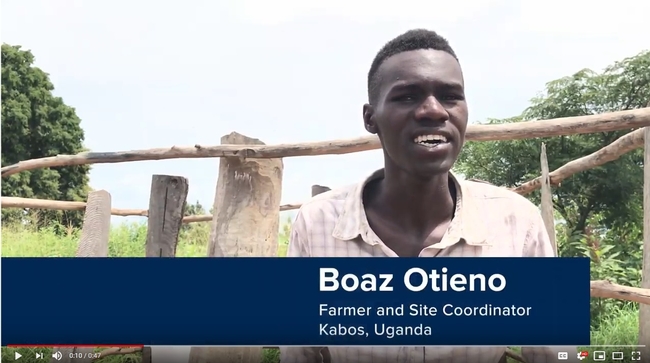
Watch a short video clip on what Boaz Otieno likes best about vegetables: https://youtu.be/aEu9BgL9aH4
Trying leafy greens from a sweet potato plant
This time of year, it can be hard to resist the pull of sweet potatoes — roasted, mashed with butter, and topped with a combination of delectable treats from maple syrup to pecans to marshmallows. But did you know that the green leaves of the sweet potato plant also have the potential to be a tasty, nutritious food?
In Ethiopia, where sweet potatoes can be a staple crop, UC Davis graduate student Lauren Howe recently helped farmers taste test the leaves and consider this familiar crop in a new culinary light.
Watch a video to learn how to prepare sweet potato leaves:
The leaves of this drought-tolerant plant offer farming households there an alternative — and nutritious — food in the lean season, while they are waiting for its starchy, tuberous roots to be ready to eat. Introducing sweet potato leaves as a food option is intended to help farmers better diversify their families' diets, to include a wider variety of vegetables in addition to staple foods, especially during the dry season.
Lauren shared her experiences in Ethiopia on the Agrilinks website, where she recently won the Agrilinks Young Scholars blog contest with her writing and a short video from the field.
Boots on the ground with sweet potato farmers in Ethiopia
Lauren traveled to Ethiopia this summer to work with an organization called Send A Cow Ethiopia (SACE), on a Trellis Fund project. As part of the Horticulture Innovation Lab, each Trellis Fund project connects an organization in a developing country with a grad student from a U.S. university, to work together to benefit local farmers, while building the capacity of both the local organization and the student.
In Ethiopia, SACE helped Lauren better understand local contexts by connecting her with farming households to interview about their current farming practices and the role of sweet potatoes in their diets.
Later they traveled to meet with a group of about 25 farmers in the Ukara community to harvest leaves, cook together and discuss their perceptions of the leaves as a vegetable option.
Reflecting on taste tests, new foods, and rural communities
Lauren's own passion for food and witnessing how food can help build community is an important part of her reflection on this experience:
"This project is about creating tasty dishes to persuade people about the nutritional benefits of a new ingredient. It is gathering families, friends and neighbors to sit down to a communal meal (already a strong Ethiopian practice), breaking bread together, sharing stories, experiences and hopes for the future."
For more, go read the rest of Lauren's blog post and check out her short video too.
Background and related international agricultural research
Lauren's experience with a Trellis Fund project in Ethiopia was supported by the Horticulture Innovation Lab, a research program led by Elizabeth Mitcham of the UC Davis Department of Plant Sciences, with funding from the U.S. Agency for International Development. With a focus on fruit and vegetable innovation, the Horticulture Innovation Lab seeks to empower smallholder farmers in developing countries to earn more income and better nourish their communities — as part of the U.S. government's global Feed the Future initiative.
Past research from the Horticulture Innovation Lab has focused on other leafy greens, specifically African indigenous vegetables, and also on sweet potatoes themselves (orange-fleshed sweet potatoes, that is). Though the program has not done in-depth research on sweet potato leaves for human consumption beyond this small Trellis Fund project, you can find more information about eating sweet potato leaves and tips in this bulletin from the University of Arkansas Cooperative Extension, and a wealth of information about sweet potato farming and gardening from the University of California Vegetable Research and Information Center.
Related Food Blog posts:
- New reason to give thanks for sweet potatoes
How orange-fleshed sweet potatoes are making a difference in some African countries - More African indigenous vegetables on more plates
A brief look at some leafy greens popular in Eastern Africa - Connecting with farmers over pineapple postharvest practices
Another Trellis student experience with a video - ‘Local' farm inspiration from half a world away
A UC Cooperative Extension specialist reflects on his time as a Trellis student
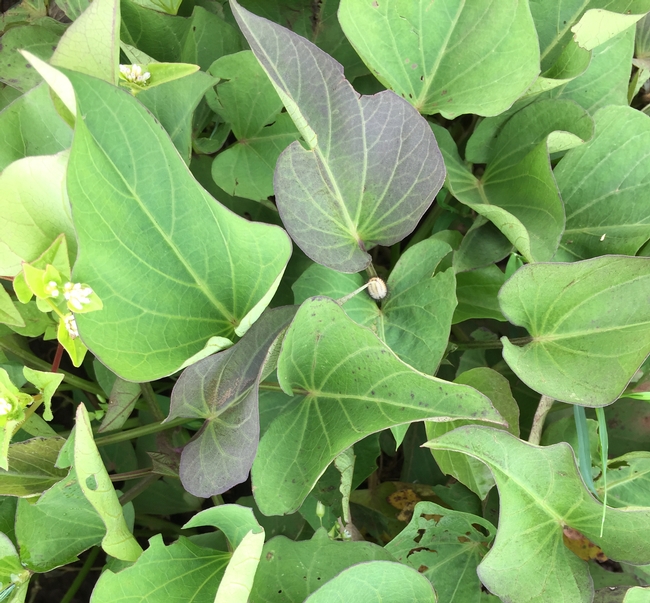
Sweet potato leaves in Ethiopia - Horticulture Innovation Lab photo by Lauren Howe/UC Davis
NPI study finds that prices for fruits and vegetables may be higher in low-income neighborhoods
Shoppers purchasing fruits and vegetables in stores located in low-income neighborhoods in California may pay more for those fruits and vegetables than shoppers in other neighborhoods, according to a study that examined prices in a large sample of stores throughout the state.
Published online in March 2018 in the journal Public Health Nutrition, the study, conducted by researchers at UC's Nutrition Policy Institute, involved more than 200 large grocery stores, 600 small markets, and 600 convenience stores in 225 low-income neighborhoods (where at least half of the population was at or below 185 percent of the Federal Poverty Level) and compared observed prices to purchased price data from chain grocery stores in the same counties during the same months.
The study found that produce prices for the items examined (apples, bananas, oranges, carrots and tomatoes) were higher in stores in low-income neighborhoods than the average prices of those items sold in stores in the same counties during the same month. Fruits and vegetables for sale in convenience stores in low-income neighborhoods were significantly more expensive than those for sale in small markets or large grocery stores. Yet even in large grocery stores the study found prices in the low-income neighborhoods to be higher than average county grocery store prices during the same month.
“Americans eat too few fruits and vegetables to support optimal health, and we know that dietary disparities among socioeconomic groups are increasing,” said study author Wendi Gosliner. “This study suggests that one important issue may be fruit and vegetable prices — not just that calorie-per-calorie fruits and vegetables are more expensive than many unhealthy foods, but also that there are equity issues in terms of relative prices in neighborhoods where lower-income Californians live.”
Additionally, the study examined the quality and availability of fruits and vegetables in stores and found that while less than half of convenience stores (41 percent) sold fresh produce, even fewer (1 in 5) sold a wide variety of fruits or vegetables, and few of the items that were for sale were rated by trained observers to be high quality (25 percent for fruits and 14 percent for vegetables).
“This study suggests that convenience stores in low-income neighborhoods currently fail to provide access to high-quality, competitively priced fresh fruits and vegetables," said Pat Crawford, nutrition expert and study author. “A healthy diet can prevent disease and reduce health care costs in the state. States need to explore new ways to help ensure that families, particularly those living in low-income neighborhoods where convenience stores are the only food retailers, have access to healthy, high-quality foods that are affordable,” Crawford added.
The study also found that convenience stores participating in federal food programs (the Supplemental Nutrition Assistance Program [SNAP] and/or the Supplemental Nutrition Program for Women, Infants, and Children [WIC]) were more likely to sell fresh produce and to offer higher quality and a wider variety of fruits and vegetables than stores not participating in either program.
The study was conducted under contract with the California Department of Public Health. Funding is from USDA SNAP. USDA is an equal opportunity provider and employer.
Building trust in food systems – here and in Cambodia
What is the role of trust in our food system? Here in the United States, our trust in food is often implicit. We can generally trust that the fruits and vegetables we buy at a grocery store or farmers market are safe to eat — and we are often free to shop without even thinking about that trust.
Between farmers and agricultural scientists too, trust often plays an important role. If you're a farmer, you need to be able to trust that investing your time or money in a new technique or in attending a workshop will indeed improve your business.
But it can be easy to forget that trust is a critical first step in many of these agricultural relationships.
Establishing trust between actors in a food system has been critical for a Horticulture Innovation Lab project in Cambodia, focused on increasing the amount of safe vegetables available to Cambodian consumers. Project leaders from UC Davis and UC ANR — Glenn Young, Jim Hill, Cary Trexler, David Miller and Karen LeGrand — are actually traveling right now in Cambodia to launch a new phase of this project. They are partnering with scientists from Cambodia's Royal University of Agriculture and the University of Battambang. The researchers plan to expand upon their past successes, working together with farmers, marketers, and input suppliers to build trust while building safe vegetable value chains.
One key to their past success was that before introducing farmers to new agricultural technologies, the researchers first connected with farmers socially, by starting community savings groups. In these savings groups, farmers could build relationships and trust, while increasing their own savings and accessing small loans.
This social aspect of the project was the focus of a video made by UC Davis graduate students Thort Chuong, Elyssa Lewis, and Katie Hoeberling. This 3-minute video was a finalist in the World Food Day Video Challenge:
Building trust and resilience in a safe vegetable value chain in Cambodia Interviews for the video were conducted as part of a student thesis and supported by the U.S. Borlaug Graduate Research Fellowship program.
Though he is now studying at UC Davis as a Fulbright Fellow, Chuong was originally hired to work with farmers on the first phase of this project in Kandal province as an agronomist and field facilitator.
“At first I just wanted to focus on the agronomy part,” he said. “But then I saw the advantages of being a [savings group] member and thought, wow, this is a great thing to do.”
In fact the advantages were so great that on the weekends he returned to his hometown, gathering his neighbors and relatives together to start their own savings groups. Members have a safe way to save money, an easier way to secure small loans, and earn a little interest too.
Farmers in these savings groups were able to save considerable amounts of money and provide loans to each other for things like seeds, field preparation, labor costs, school fees, wedding costs, even in one case a new house — with each member contributing $5-25 per week for a year.
With trust and community established, some of the farmers in the savings groups also decided to try out a new agricultural technology in partnership with the scientists, using nethouses for pest management to avoid spraying pesticides. (In many countries where pesticide information is inaccessible to the average farmer, it is not uncommon for farmers to keep a separate garden to feed their family — in order to avoid eating even their own crops that they are selling to the market.)
The new, safe vegetable value chain they were part of grew and strengthened, as the international team connected these farmers to a marketer who needed to source vegetables grown without pesticides. That marketer then sells those vegetables to consumers in the capital city of Phnom Penh, who were able to trust the vegetables they bought from her are indeed safe to eat.
The Horticulture Innovation Lab is led by a team at UC Davis, with funding from the U.S. Agency for International Development, as part of the U.S. government's global hunger and food security initiative called Feed the Future. Learn more about Horticulture Innovation Lab researchers and their projects in Asia, Africa and Central America.
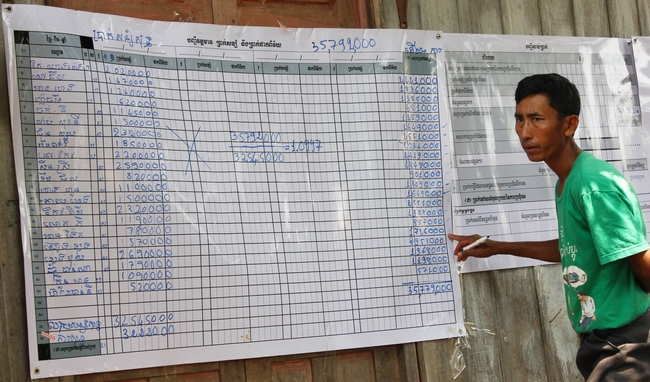
As the savings group secretary, Nov Keo tallies up the year's total savings, loans, and interest during the end-of-year ceremony. He was also one of the first farmers to try using a nethouse to grow "safe vegetables" for the Phnom Penh market.
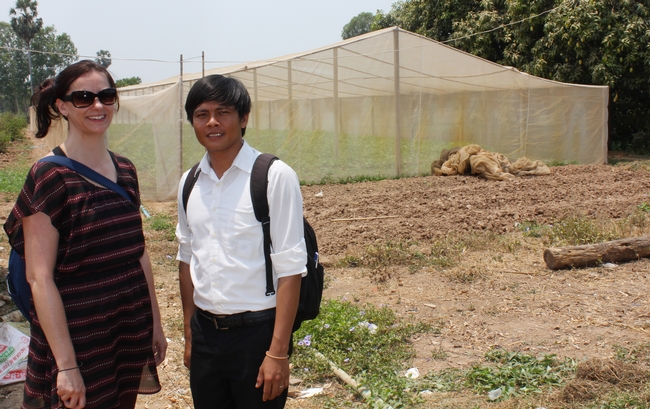
UC Davis researcher Karen LeGrand with Thort Chuong, in front of another farmer's nethouse in Cambodia built after they helped connect scientists, farmers, and marketers with technologies from the Horticulture Innovation Lab.
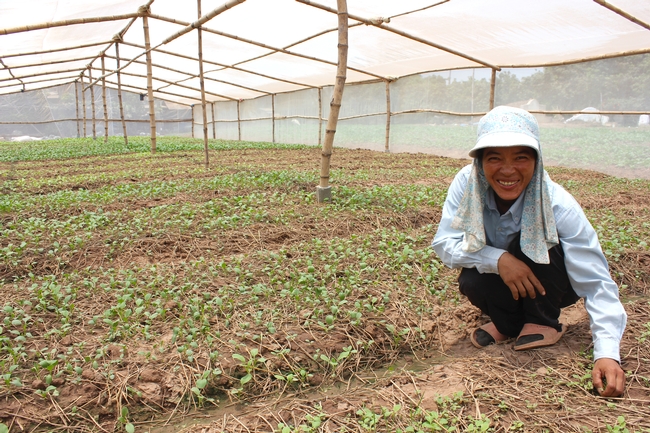
Cheng Sokhim is one of the farmers who started using a nethouse for safer pest control and to earn higher prices for her leafy greens such as kale, Chinese mustard, bok choy and curly leaf lettuce.


